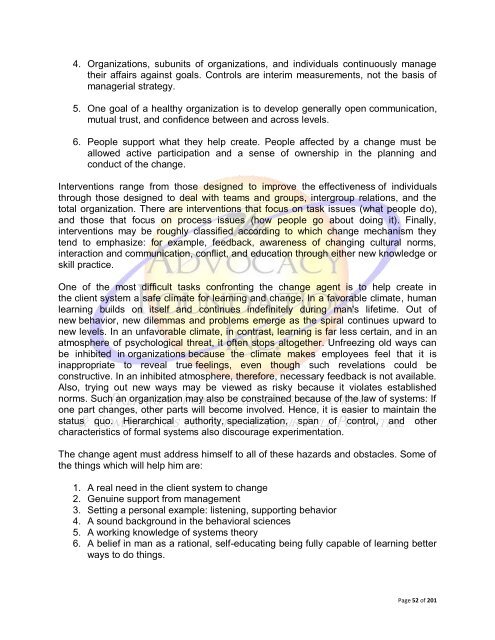ComeUnity CAPACITY BUILDING
ComeUnity CAPACITY BUILDING
ComeUnity CAPACITY BUILDING
Create successful ePaper yourself
Turn your PDF publications into a flip-book with our unique Google optimized e-Paper software.
4. Organizations, subunits of organizations, and individuals continuously manage<br />
their affairs against goals. Controls are interim measurements, not the basis of<br />
managerial strategy.<br />
5. One goal of a healthy organization is to develop generally open communication,<br />
mutual trust, and confidence between and across levels.<br />
6. People support what they help create. People affected by a change must be<br />
allowed active participation and a sense of ownership in the planning and<br />
conduct of the change.<br />
Interventions range from those designed to improve the effectiveness of individuals<br />
through those designed to deal with teams and groups, intergroup relations, and the<br />
total organization. There are interventions that focus on task issues (what people do),<br />
and those that focus on process issues (how people go about doing it). Finally,<br />
interventions may be roughly classified according to which change mechanism they<br />
tend to emphasize: for example, feedback, awareness of changing cultural norms,<br />
interaction and communication, conflict, and education through either new knowledge or<br />
skill practice.<br />
One of the most difficult tasks confronting the change agent is to help create in<br />
the client system a safe climate for learning and change. In a favorable climate, human<br />
learning builds on itself and continues indefinitely during man's lifetime. Out of<br />
new behavior, new dilemmas and problems emerge as the spiral continues upward to<br />
new levels. In an unfavorable climate, in contrast, learning is far less certain, and in an<br />
atmosphere of psychological threat, it often stops altogether. Unfreezing old ways can<br />
be inhibited in organizations because the climate makes employees feel that it is<br />
inappropriate to reveal true feelings, even though such revelations could be<br />
constructive. In an inhibited atmosphere, therefore, necessary feedback is not available.<br />
Also, trying out new ways may be viewed as risky because it violates established<br />
norms. Such an organization may also be constrained because of the law of systems: If<br />
one part changes, other parts will become involved. Hence, it is easier to maintain the<br />
status quo. Hierarchical authority, specialization, span of control, and other<br />
characteristics of formal systems also discourage experimentation.<br />
The change agent must address himself to all of these hazards and obstacles. Some of<br />
the things which will help him are:<br />
1. A real need in the client system to change<br />
2. Genuine support from management<br />
3. Setting a personal example: listening, supporting behavior<br />
4. A sound background in the behavioral sciences<br />
5. A working knowledge of systems theory<br />
6. A belief in man as a rational, self-educating being fully capable of learning better<br />
ways to do things.<br />
Page 52 of 201

















